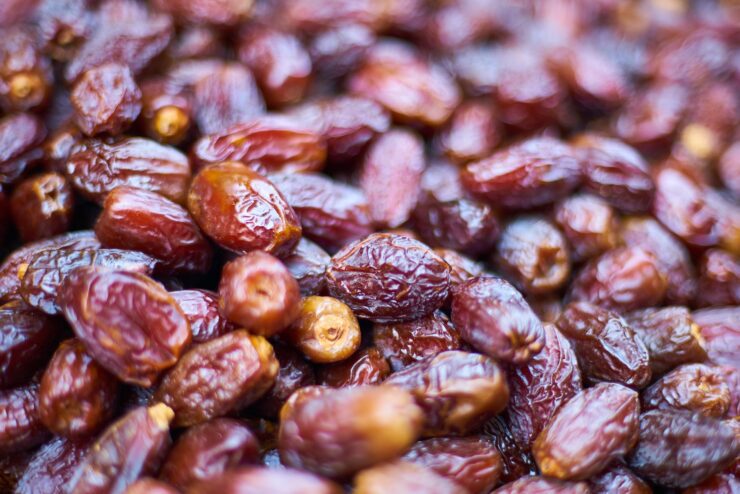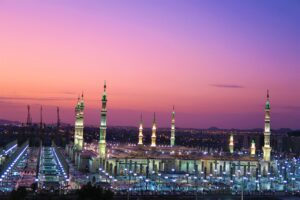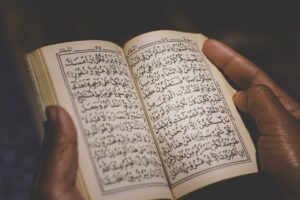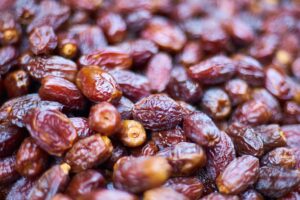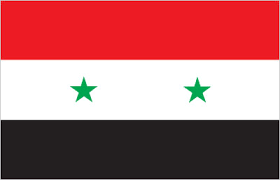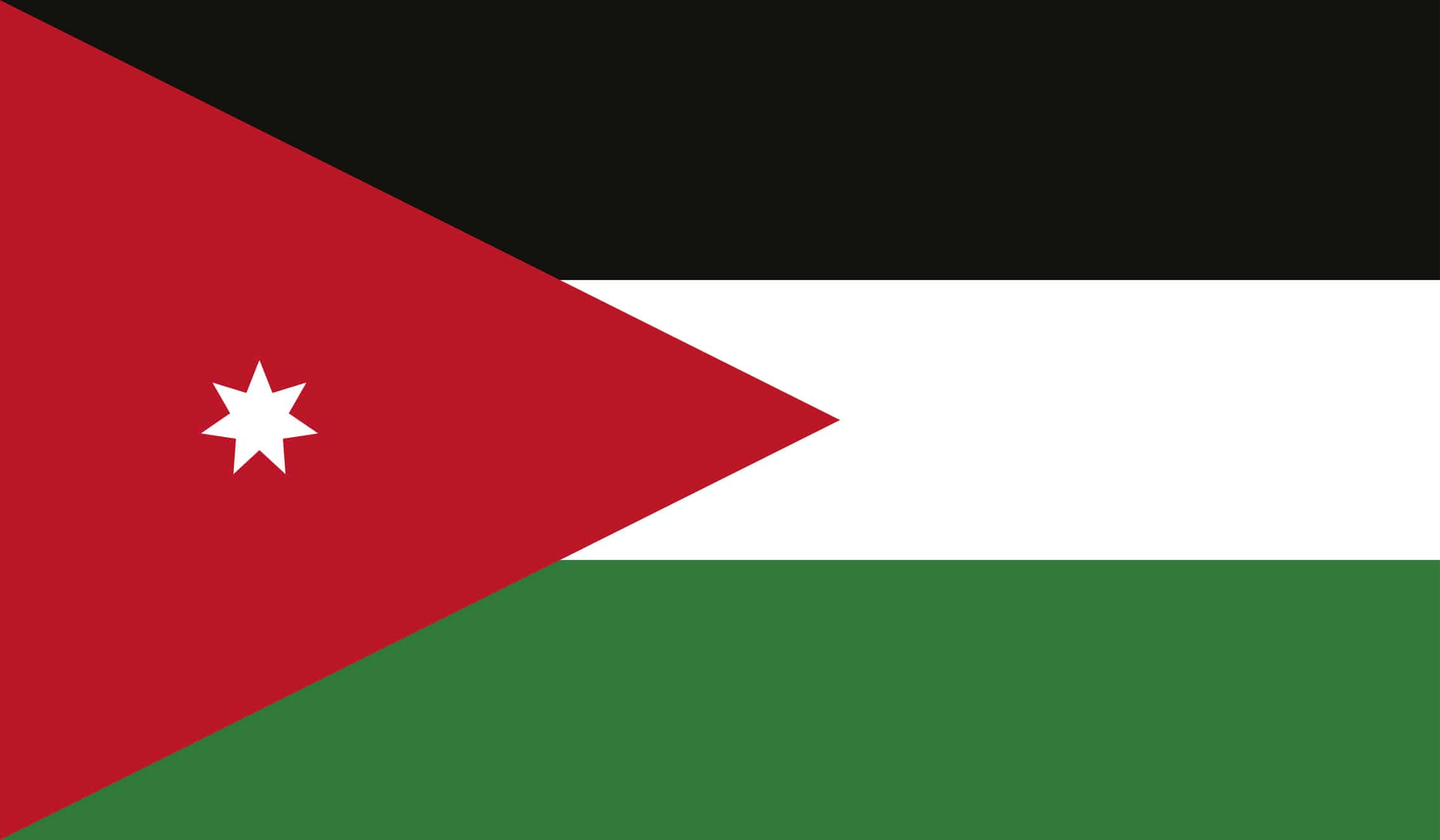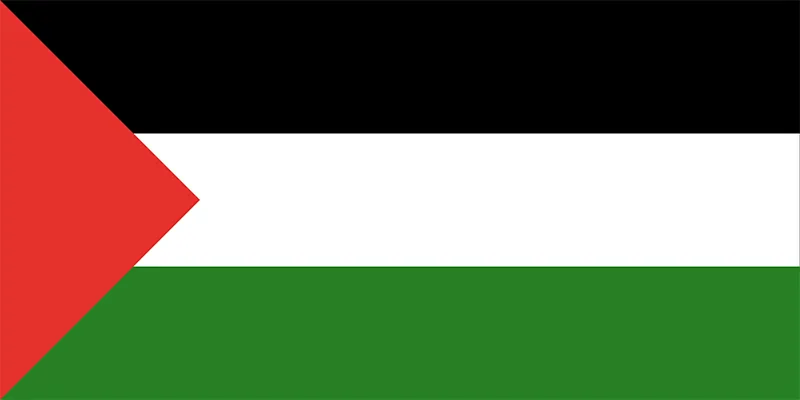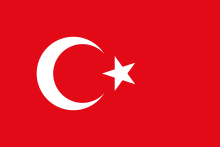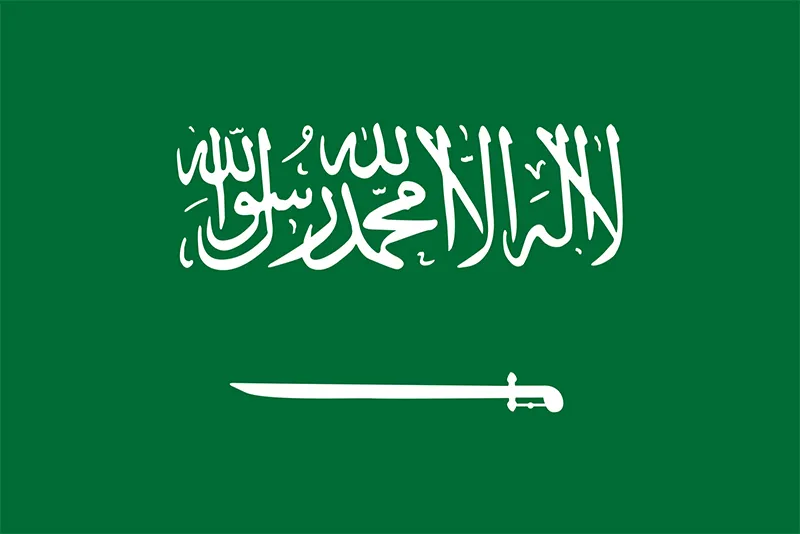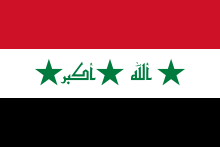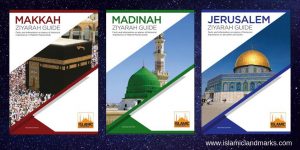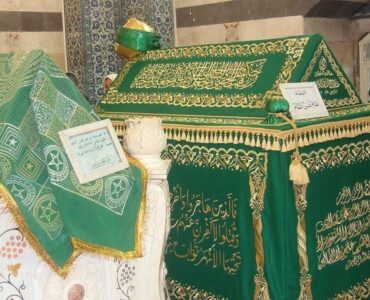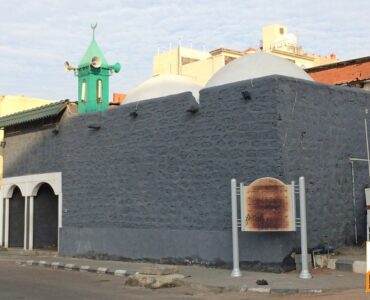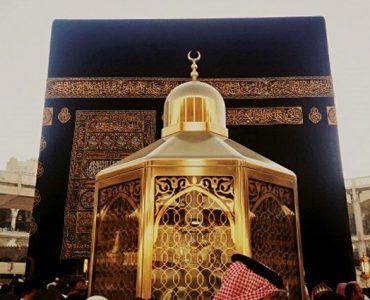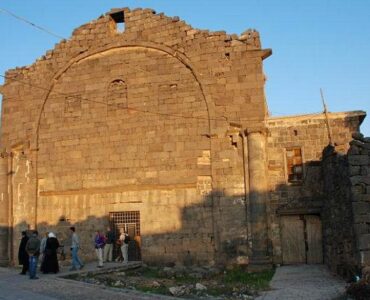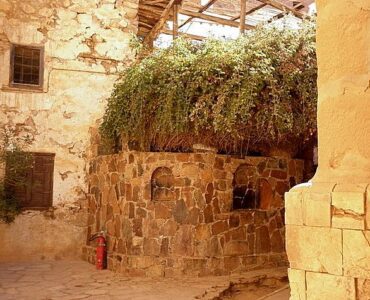Saudi Arabia is home to Mecca and Medina, the two most sacred cities for Muslims in the world. Millions of Muslims from around the world visit Medina as a gesture to pay tribute to the Holy Prophet (P.B.U.H.) when they visit the country to perform Umrah or Hajj.
Medina, also known as Madina or Al Madinah Al Munawarah, is where the Prophet Muhammad (P.B.U.H.) migrated from Mecca in 622 A.D. The Prophet (P.B.U.H.) continued to live in Medina and preached Islam until his death in 632 A.D. The Prophet (P.B.U.H.) is buried in Medina, in his sacred chamber known as the Rawdah in Al Masjid an Nabawi, also known as the Prophet’s Mosque (P.B.U.H).
In this article, we highlight some interesting facts about Medina. But before we get into the facts, let’s look at a brief history of Medina and the significance of the city in Islam.
What Is Medina?
Medina is one of the two holy cities in Islam that make a key destination for millions of Muslims from around the world who visit Saudi Arabia to perform the pilgrimage.
Medina, officially known as Al Madinah Al Munawarah, is centered around the Prophet’s Mosque (P.B.U.H) known as Masjid-e-Nabawi. Prophet Muhammad (P.B.U.H.) constructed the mosque adjacent to where he lived. Today, Masjid-e-Nabawi is the final resting place of the Prophet Muhammad (P.B.U.H.) and his two beloved companions, Abu Bakr (R.A.) and Umer (R.A.)
While visiting Medina, the holiest city, is not a ritual of any pilgrimage (Umrah or Hajj), however, there are several virtues of visiting the city and praying in the Prophet’s Mosque (P.B.U.H). Abu Hurayrah narrated that the Prophet (P.B.U.H.) said, “A prayer in this mosque of mine is a thousand times greater than a prayer in other than it, except for the Masjid al-Haram.” [Sahih Bukhari; Sahih Muslim]
Medina’s name is usually written as Medina or Madinah. However, it’s complete name is Al Medina Al Munawarah, which means “the Enlightened City.”
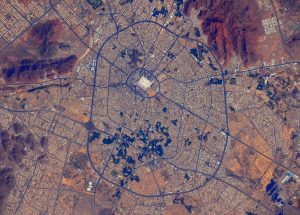

Brief History of Medina
Before Prophet Muhammad (P.B.U.H.) migrated to Medina, the city was known as Yathrib. It was primarily a settlement around an oasis which can be dated back to the 6th Century.
The establishment resulted from a battle between the Romans and the Jews. The latter escaped the war site and decided to settle in Medina.
Since the beginning till the Holy Prophet’s (P.B.U.H.) migration, Yathrib was predominantly inhabited by Jews.
Following the Prophet Muhammad’s (P.B.U.H.) migration, Islam quickly spread in the region, and the city was known as Medina.
Why Is Medina Important in Islam?
Al Madinah Al Munawarah is a sacred city for Muslims.
While it is not the birthplace of the last Prophet (P.B.U.H.), it holds a special place in Islam for various reasons.
The Holy Prophet (P.B.U.H.) migrated to Medina, and since then, the holiest city has become the center of Muslim leadership under the Prophet (P.B.U.H.) of Allah. Moreover, the Prophet (P.B.U.H.) along with his companions built the Prophet’s Mosque there.
Madina also holds a special place for Muslims as the Holy Prophet’s (P.B.U.H) final resting place is in this city where Muslims from all over the world can visit the Prophet (P.B.U.H.)
Muslims highly regard the sacred city of Medina because the three most significant mosques in Islamic history are located in the city.
Madina is home to Masjid-e-Nabawi, Masjid-e-Qiblatayn and Masjid Al-Quba.
Masjid-e-Nabawi is sacred to Muslims as it was established by the Prophet (P.B.U.H.) himself. Moreover, Masjid-e-Qiblatayn is the mosque where the Prophet (P.B.U.H.) received the commandment to change the direction of Qibla.
Masjid Quba holds great significance for Muslims as Prophet Muhammad (P.B.U.H.) said, “Whoever purifies himself in his house, then comes to the Quba mosque and prays in it, he will have a reward like the Umrah pilgrimage.”
One of the other interesting facts about Medina is that the Prophet Muhammad (P.B.U.H.) continued to receive revelations in this city. The revelations in Medina are recorded in the Quran as the Madni Surahs.
Anas (R.A.) reported the Prophet Muhammad (P.B.U.H.) saying that “For the believer, Medina is the best place. If only they could understand its virtue fully, they would never leave it, and whoever departs from Medina, having become disenchanted with it, Allah will send someone better to replace him. And whoever bears patiently the ordeals of Medina, for him shall I be an intercessor (or witness) on the Day of Qiyamah.” (Muslim)
What Do Muslims Do in Medina?
On their visit to the Holy City, Muslims are expected to do several things.
One of the most important things to do in Madina is to pray in the Prophet’s Mosque (P.B.U.H). The Hadith
“The prayer in my Masjid (Masjid An-Nabawi) is better than one thousand (1000) prayers in any other masjid with the exception of Masjid Al-Haram, and a prayer in Masjid Al-Haram is better than one hundred thousand (100,000) prayers” signifies the importance of praying in Masjid an-Nabawi.
Therefore, while in Medina, the most important thing to do is to pray in the Prophet’s Mosque (P.B.U.H).
Muslims must also visit the Rawdah when in Medina. The Rawdah is the area between the Prophet’s (P.B.U.H) house and the pulpit. It was eventually turned into the Prophet’s (P.B.U.H) burial chamber and is regarded as one of the Riyāḍ Al-Jannah.
Riyad Al-Jannah refers to the “Gardens of Paradise.”
When visiting the Rawdah, Muslims must pray 2 Rakahs Nafl anywhere in the Rawdah, preferably behind Ustuwaanat Aisha (the Pillar of Aisha).
It is also recommended to pray Tahiyyatul Masjid, which is the prayer of greeting the mosque. Performing two Rakahs of Tahiyyatul Masjid after entering the Rawdah brings numerous virtues.
One can also spend their time in the Rawdah to praise Allah S.W.T. and glorify Him for providing you an opportunity to visit the Prophet’s Mosque (P.B.U.H).
Following the completion of prayers, walk towards the grave of the Prophet Muhammad (P.B.U.H.) to offer your prayers and blessings for the Prophet (P.B.U.H.). As you walk towards the Prophet’s (P.B.U.H) grave, your back will be facing the Qibla, and you’ll be standing exactly in front of Prophet Muhammad’s (P.B.U.H.) face.
It’s where you should humbly recite Salam in low, and respectful tone:
اَلسَّلَامُ عَلَيْكَ يَا رَسُوْلَ اللهِ
Translation: Peace be upon you, O Messenger of Allah.
Then you should move a little to the right and say blessings for the Prophet’s (p. B.U.H.) most beloved companions, Abu Bakr Siddiq (R.A.) and Umer (R.A.) and pray for them.
Apart from praying in the Prophet’s Mosque (P.B.U.H) and visiting the Rawdah, Muslims can perform ziyarat when in Medina.
The sacred city of Madinah is an important destination for Muslims, home to various significant mosques, mountains, caves, and battlefields.
Visitors to Madina can visit Masjid-e-Quba and Masjid-al-Qiblatayn and pray in these mosques. They can also visit various other sites while they take the road to travel to different parts of the city like Mount Uhud, Jannat-al-Baqi, and Al Madinah Museum.
Facts about Medina
Now that you have enough information about the city of the Prophet (P.B.U.H.), let’s delve into some interesting facts about Medina.
Medina Population
Millions of Muslims from around the world visit the Holy City each year. However, it is home to a little over 1.5 million people.
With an estimated population of over 1.5 million individuals, Medina is the 4th most populous city in Saudi Arabia.
The Migration to Medina Marks the Beginning of the Hijri Calendar
The migration of Prophet Muhammad (P.B.U.H.) from Mecca to Madinah holds a special significance for Muslims. The event marked the beginning of the Hijri calendar.
Al Hijri marks the Prophet’s (P.B.U.H.) migration with the lunar year starting from Muharram and ending in Dhu al-Hajj.
How Old Is Mecca?
While we discuss interesting facts about Medina, let’s not forget the significance of Mecca, the holiest site for Muslims worldwide.
Mecca, also known as Makkah, is an ancient settlement. The earliest settlements in Mecca can be dated back to 5,000 years ago, as the well of Zamzam has been flowing since then.
The Zamzam well first sprang from under the feet of Prophet Ismael (A.S.) when Prophet Ibrahim (A.S.) left his wife and son in the deserted area of Mecca. Years later, upon his return, Prophet Ibrahim (A.S.) found his son all grown up into a young man living in a settlement in Mecca.
What Was the Old Name of Medina?
Before the Holy Prophet (P.B.U.H.) migrated to Madinah, the city was known as Yathrib. However, when the Prophet (P.B.U.H.) migrated to the city, he changed the name to Medina, which means the city of the Prophet (P.B.U.H.)
Medina Is the Burial Place of the Holy Prophet Mohammad (P.B.U.H.) and Many of His Companions
Al Madina Al Munawarah, known as “the enlightened city” and “the city of the Prophet (P.B.U.H.),” is one of the holiest places in Islam.
It holds a special place for Muslims as it is the city where the Prophet Mohammad (P.B.U.H.) is buried.
Masjid-e-Nabawi is the Holy Prophet’s (P.B.U.H) final resting place.
Moreover, Jannat-al-Baqi is located in Madina, the burial place for many of the Prophet’s (P.B.U.H.) beloved companions. Aisha, the Prophet’s (P.B.U.H.) most beloved wife is also buried in Jannat-al-Baqi.
Medina Is Home to Several Significant Mosques in the Islamic World
Islam quickly gained popularity in Medina and surrounding areas following the Prophet’s (P.B.U.H.) migration.
As a result, the city became home to several significant mosques in the Islamic world.
Immediately following the migration, the Prophet Muhammad (P.B.U.H.) was constructed in Masjid-e-Nabawi. Today, it is the second-largest mosque in the world and one of the two holiest sites for Muslims.
While the Prophet’s Mosque (P.B.U.H.) makes Medina special for Muslims, it’s also home to other important mosques like Masjid Al-Quba and Masjid-e-Qiblatayn.
Quranic Revelations Continued in Medina
One lesser-known interesting fact about Medina is that the Holy Prophet (P.B.U.H.) continued to receive revelation in Medina.
Out of the 114 chapters in the Quran, 28 were revealed in different parts of Madina including the Prophet Mosque (PBUH). The Quranic chapters revealed in Madina are known as Madni Surahs. These chapters in the Quran address the problems of Muslims after migration and offer solutions that finally resulted in the conquest of Mecca.
Muslims Visiting Mecca for Hajj or Umrah Must Go to Medina
All physically and financially abled Muslims must perform Hajj once in a lifetime.
Moreover, devout Muslims can perform the pilgrimage (Umrah) to the holy Kaaba in Mecca.
However, on every pilgrimage, it’s essential for Muslims to visit Al-Masjid an-Nabawi, pray there, and say blessings for the Prophet (P.B.U.H.).
Can Non-Muslims Go to Medina?
Unlike the Holy Mecca, non-Muslims are allowed to enter Medina.
However, they cannot enter Al-Masjid Al-Nabawi.
The Nabawi Square, the city center in Medina, is out of reach for non-Muslims as the location holds Al-Masjid Al-Nabawi.
However, non-Muslims can visit the outskirts of the mosque and take pictures of the mosque. Moreover, they can also explore other areas of the city.
Medina Is Known for Its Date Production
Saudi Arabia is home to a large area of the Arabian Desert. Until recently, the area received little or no rainfall, and agriculture was scanty.
Yet, despite unfavorable harvesting conditions, Medina is one of the top producers of dates in the world. It ranks second in the production of dates, following Egypt, and is home to over 300 different varieties of dates.
Summary – Facts about Medina
Medina, the city of the Prophet (P.B.U.H.), is one of the most sacred sites for Muslims around the world. The city is integral to Islam as that’s where the Prophet (P.B.U.H.) migrated and constructed his mosque, which also served as the final resting place for the Prophet (P.B.U.H.). The migration to Medina marks the beginning of a new calendar for Muslims: Al Hijri.
It was following this migration that the Prophet (P.B.U.H.) continued to get revelations, and Islam spread quickly in the region. As a result, Madinah served as the center for leadership for the Muslim community during the early rise of Islam

